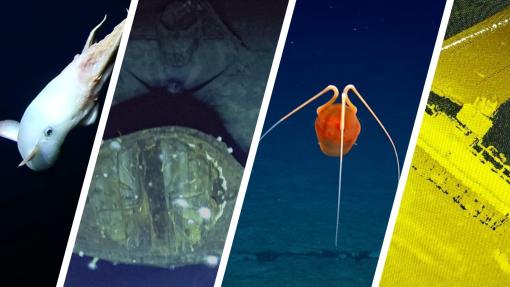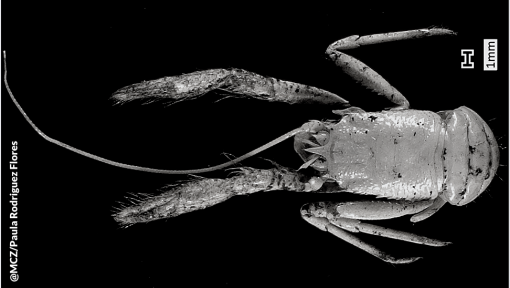OET’s Top 10 WOW Moments of 2023

Take a look back at some of the biggest “WOW” moments of 2023 for Ocean Exploration Trust (OET) and the Corps of Exploration as we explored the sea and tested new technology across the Eastern and Central Pacific Ocean.
E/V Nautilus Reveals USS Yorktown for First Time in 25 Years
Ocean Exploration Trust’s survey of USS Yorktown during our Ala ʻAumoana Kai Uli expedition was the first time the world could witness this Battle of Midway wreck in real-time. The site was discovered 25 years ago, located during a joint U.S. Navy and National Geographic Society expedition led by Dr. Robert Ballard, president and founder of Ocean Exploration Trust. All dives in the Battle of Midway battlefield were launched and closed with protocol ceremonies to honor this place and all who lost their lives in ways that reflected their significance to Kānaka ʻOiwi (Native Hawaiian), Japanese, and U.S. military families and communities.
Mysterious Jellyfish Found in Remote Pacific Depths
Our team was stumped when we encountered this mysterious gelatinous creature while diving on a previously unexplored guyot north-northwest of Kingman Reef. Midwater expert Dr. Dhugal Lindsay helped us to identify this jellyfish as a member of the order Narcomedusae, and an undescribed species within the genus Bathykorus. This is only the second encounter with this animal, first spotted by NOAA Ocean Exploration’s ship Okeanos Explorer in 2015. Using the rays on top of the bell, we believe this animal likely eats other gelatinous animals like jellies and/or swimming sea cucumbers. Different from all other species in the genus, the animal’s brown color indicates to experts that this is a predator of bioluminescent prey.
Testing New Camera Technology To Bring The Deep Sea to 3D
During our Ocean Exploration Through Advanced Imagery expedition, the team had the exciting opportunity to test a new widefield camera array system co-developed by the OET and Sexton Corporation to expand how we gather data from the deep ocean. Across two weeks, we challenged ourselves and the technology by exploring a variety of complex underwater terrains throughout the Hawaiian Archipelago, including cliffs, pinnacles, coral gardens, and the active submarine volcano Kamaʻehuakanaloa Seamount, and developing models based on new data. OET and our partners are proud to have developed a camera capable of recording discoveries with the highest production quality available for deep ocean exploration, and we can't wait to continue sharing its evolution with the world.
“Ghostly” Dumbo Octopus in the Deep Sea
Looking “ghostly” in front of our ROV Hercules' camera, our Corps of Exploration spotted this cephalopod hovering above ROV Hercules as it explored the ocean floor 1,682 meters (5,518 feet, 920 fathoms) deep on an unnamed seamount in Papahānaumokuākea Marine National Monument. Watch as this fan-favorite deep sea creature hovers delicately in front of our camera, reminding us of the beauty of this special place.
Updated Mesobot Provides Stunning Twilight Zone Footage
Woods Hole Oceanographic Institution’s (HROV) Mesobot returned for our third iteration of the Ocean Exploration Cooperative Institute (OECI) technology collaboration with new systems upgrading its collaborative exploration power. Mesobot’s brand-new cameras have captured exciting biodiversity from the ocean’s twilight zone, including luminescent siphonophores and salps, squid, swordfish, and even an oceanic whitetip shark!
First Visual Survey of IJN Akagi 赤城 and Deep Sea Dive on IJN Kaga 加賀: Historic Battle of Midway Shipwrecks
In September, 2023, the E/V Nautilus team spent multiple days exploring wrecks from the historic Battle of Midway, including 14 hours surveying Japanese aircraft carrier Imperial Japanese Navy (IJN) Akagi 赤城, examining battle and seafloor collision damage in the ship’s structure: the first time anyone has laid eyes on the vessel since sinking. We also completed a comprehensive survey of Imperial Japanese Navy (IJN) Kaga 加賀, the Japanese aircraft carrier sunk during the Battle of Midway in June 1942 in its final resting place within Papahānaumokuākea Marine National Monument (PMNM), the largest protected area in the U.S. and one of the largest in the world. The dive was launched and closed with protocol ceremonies to honor this place and all who lost their lives in ways that reflected their significance to Kānaka ʻOiwi (Native Hawaiian), Japanese, and U.S. military families and communities.
1000th Dive off Nautilus: Wildlife and Wonder During a Milestone Dive for ROV Hercules
For the past 15 years, the Ocean Exploration Trust has explored the seafloor and shared discoveries live with the world. ROV Hercules has led our deep sea exploration, and this highlight video celebrates its 1000th dive from E/V Nautilus (which was preceded by many more prior to Nautilus)! Check out some of the awesome seafloor sightings from this celebratory dive that took place on August 24, 2023 about 10 nm east of Johnston Atoll during our NA153 expedition.
Revisiting a Whale Fall on Clayoquot Slope
During our NA151 expedition to the waters off British Columbia, OET and Ocean Networks Canada (ONC) revisited the site of a whale fall 1,250 meters deep at the Clayoquot Slope Bullseye site to see how the ecosystem has progressed over the years. Whale falls represent an oasis of food supply in an often food-poor deep-sea floor and sustain a diverse assemblage of marine organisms for up to decades. ONC has been observing this particular whale fall since 2012 during its yearly visits to maintain the observatory’s seafloor instruments at Bullseye, where scientists are also interested in studying and monitoring the processes controlling methane gas seeping from the seafloor.
Scientists Discover Five New Species of Deep-Sea Squat Lobster: One Named After Exploration Vessel Nautilus

The deep sea invertebrates known as squat lobsters might be up for a brand new classification, thanks to research on samples housed at various museums, including some recently gathered by OET and other ocean exploration organizations. Researchers in the Department of Organismic and Evolutionary Biology (OEB) at Harvard University have described five new species of squat lobsters from the Eastern Pacific. The recently published study used an analysis of morphological characteristics and DNA to describe five new species of squat lobsters and expand the known geographic distribution of several previously known species.
Spiral Iridigorgia Coral Taller Than ROV Hercules
Spotted on an unnamed guyot northwest of Kingman Reef at around 1,200m deep, this Iridigorgia magnaspiralis coral was pushing 3 meters tall. Towering above its seafloor neighbors this colony lifts its polyp whirls into currents slowed down closer to the seafloor by friction with the rocks. With a few branches colonized by benthic ctenophores (aka comb jellies) and providing a perch for a squat lobster, this massive coral provides an essential home and foundation for plankton predators. Check out these beautiful views from ROV Hercules and ROV Atalanta, showing us this massive underwater micro-ecosystem. Wow-moments like this remind us of all the beauty yet to be discovered under the waves.
